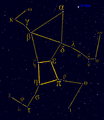Hercules (constellation) facts for kids
| Constellation | |

List of stars in Hercules
|
|
| Abbreviation | Her genitive = Herculis |
|---|---|
| Pronunciation | genitive |
| Symbolism | Heracles |
| Right ascension | 17h |
| Declination | +30° |
| Quadrant | NQ3 |
| Area | 1225 sq. deg. (5th) |
| Main stars | 14, 22 |
| Bayer/Flamsteed stars |
106 |
| Stars with planets | 15 |
| Stars brighter than 3.00m | 2 |
| Stars within 10.00 pc (32.62 ly) | 9 |
| Brightest star | β Her (Kornephoros) (2.78m) |
| Messier objects | 2 |
| Meteor showers | Tau Herculids |
| Bordering constellations |
Draco Boötes Corona Borealis Serpens Caput Ophiuchus Aquila Sagitta Vulpecula Lyra |
| Visible at latitudes between +90° and −50°. Best visible at 21:00 (9 p.m.) during the month of July. |
|
Hercules is a large and famous constellation in the northern part of our night sky. It looks like a strong hero, named after the legendary Hercules from ancient Greek mythology. This constellation was first listed by a famous astronomer named Ptolemy way back around 150 CE. Today, it's still one of the 88 official constellations recognized by the International Astronomical Union.
Contents
Finding Hercules in the Night Sky
Hercules is a big constellation, ranking as the fifth largest in the sky. It covers a huge area! You can usually spot it best in July from the Northern Hemisphere. It's located between several other well-known constellations.
Where to Look for Hercules
To find Hercules, you can look for its neighbors. It borders Draco, Boötes, Corona Borealis, Serpens Caput, Ophiuchus, Aquila, Sagitta, Vulpecula, and Lyra. Knowing these nearby constellations can help you pinpoint Hercules.
Stars and Objects in Hercules
Even though Hercules is large, its brightest stars are not super bright. The brightest star in Hercules is called Kornephoros. It shines with a magnitude of 2.78, which is fairly dim compared to some other stars.
Deep-Sky Objects to Explore
Hercules is home to some amazing deep-sky objects that astronomers love to observe. These include two special objects from the Messier Catalog.
- Messier 13 (M13): This is a spectacular globular cluster. It's one of the brightest and best-known globular clusters in the entire northern sky. It contains hundreds of thousands of stars, all packed closely together.
- Messier 92 (M92): Another beautiful globular cluster found in Hercules. While not as famous as M13, it's still a wonderful sight through a telescope.
Meteor Showers from Hercules
Sometimes, meteor showers appear to come from the direction of Hercules. One such shower is the Tau Herculids. These are tiny pieces of space dust and rock that burn up in our atmosphere, creating streaks of light.
The Myth of Hercules
The constellation Hercules is named after the famous hero from Greek mythology. Hercules was known for his incredible strength and courage. He completed twelve difficult tasks, often called the "Twelve Labours of Hercules." These tasks included fighting monsters and performing amazing feats. The constellation shows him kneeling, often depicted holding a club or a lion's skin.
Images for kids
-
Traditional view of the Hercules constellation highlighting the quadrangle which forms the Keystone asterism.
-
An alternative way to connect the stars of the constellation Hercules, suggested by H.A. Rey. Here, Hercules is shown with his head at the top.
-
Hercules as depicted in Urania's Mirror, a set of constellation cards published in London c.1825. The figure appears upside down in the sky relative to neighbouring constellations. The former constellation of Cerberus is held by Hercules before its stars were part of the constellation.
See also
 In Spanish: Hércules (constelación) para niños
In Spanish: Hércules (constelación) para niños




